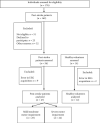Intrahemispheric EEG: A New Perspective for Quantitative EEG Assessment in Poststroke Individuals
- PMID: 34603441
- PMCID: PMC8481048
- DOI: 10.1155/2021/5664647
Intrahemispheric EEG: A New Perspective for Quantitative EEG Assessment in Poststroke Individuals
Abstract
The ratio between slower and faster frequencies of brain activity may change after stroke. However, few studies have used quantitative electroencephalography (qEEG) index of ratios between slower and faster frequencies such as the delta/alpha ratio (DAR) and the power ratio index (PRI; delta + theta/alpha + beta) for investigating the difference between the affected and unaffected hemisphere poststroke. Here, we proposed a new perspective for analyzing DAR and PRI within each hemisphere and investigated the motor impairment-related interhemispheric frequency oscillations. Forty-seven poststroke subjects and twelve healthy controls were included in the study. Severity of upper limb motor impairment was classified according to the Fugl-Meyer assessment in mild/moderate (n = 25) and severe (n = 22). The qEEG indexes (PRI and DAR) were computed for each hemisphere (intrahemispheric index) and for both hemispheres (cerebral index). Considering the cerebral index (DAR and PRI), our results showed a slowing in brain activity in poststroke patients when compared to healthy controls. Only the intrahemispheric PRI index was able to find significant interhemispheric differences of frequency oscillations. Despite being unable to detect interhemispheric differences, the DAR index seems to be more sensitive to detect motor impairment-related frequency oscillations. The intrahemispheric PRI index may provide insights into therapeutic approaches for interhemispheric asymmetry after stroke.
Copyright © 2021 Rodrigo Brito et al.
Conflict of interest statement
The authors report no conflicts of interest.
References
-
- WHO. WHO | The Atlas of Heart Disease and Stroke . WHO; 2010.
-
- Nowak D. A., Grefkes C., Ameli M., Fink G. R. Interhemispheric competition after stroke: brain stimulation to enhance recovery of function of the affected hand. Neurorehabilitation and Neural Repair . 2009;23(7):641–656. - PubMed
-
- van Meer M. P. A., van der Marel K., Wang K., et al. Recovery of sensorimotor function after experimental stroke correlates with restoration of resting-state interhemispheric functional connectivity. Journal of Neuroscience . 2010;30(11):3964–3972. doi: 10.1523/JNEUROSCI.5709-09.2010. - DOI - PMC - PubMed
-
- Murase N., Duque J., Mazzocchio R., Cohen L. G. Influence of interhemispheric interactions on motor function in chronic stroke. Annals of Neurology . 2004;55(3):400–409. - PubMed
Publication types
MeSH terms
LinkOut - more resources
Full Text Sources
Medical


